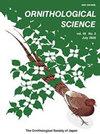Evidence of Torpor in a Tropical Passerine, the Scarlet-Backed Flowerpecker Dicaeum cruentatum
IF 0.3
4区 生物学
Q4 ORNITHOLOGY
引用次数: 2
Abstract
Abstract The Scarlet-backed Flowerpecker Dicaeum cruentatum (Dicaeidae, Passeriformes), a sedentary species of Southeast Asia, is among the smallest passerine birds (5–6 g). Despite its very small size, it feeds mainly on plant foods, such as berries, nectar, and green seeds. We found that in conditions of likely food shortage Scarlet-backed Flowerpeckers were able to greatly reduce their metabolic rate at a relatively high ambient temperature (26–28°C). This is within the thermoneutral zone of most tropical birds, although slightly cooler than the normal lower critical temperature of flowerpeckers. In this state, the resting metabolic rate (RMR) of three individual, free-living Scarlet-backed Flowerpeckers from Vietnam averaged 1.57 mL O2/g*h, which was 3.4 times lower than their non-torpid RMR, measured at the same ambient temperature (Ta=∼27°C) and 2.5 time lower than their basal metabolic rate (BMR) measured at Ta=∼31°C. We did not measure the body temperature (Tb) of these individuals, but the dramatically low oxygen consumption provides evidence of torpor, an energy-saving physiological state, which is very rare among passerine birds. The skin Tb of active flowerpeckers, just before nocturnal RMR measurements, averaged 41.1°C (their cloacal Tb was 41.2°C), while in resting non-torpid birds at night the skin Tb averaged 36.3°C. Our report is the first quantitative evidence of torpor in the family Dicaeidae.热带雀形目,红背啄花鸟(Dicaeum cruentatum)冬眠的证据
摘要Scarlet backed Flowerpecer Dicaeum crutetum(Dicaeidae,雀形目)是东南亚的一种定居物种,是最小的雀形目鸟类之一(5-6克)。尽管体型很小,但它主要以植物性食物为食,如浆果、花蜜和绿色种子。我们发现,在可能出现食物短缺的情况下,猩红背Flowerpackers能够在相对较高的环境温度(26-28°C)下大幅降低其代谢率。这是在大多数热带鸟类的温度中性区内,尽管比啄花鸟的正常低临界温度略低。在这种状态下,来自越南的三只单独的、自由生活的Scarlet背Flowerpackers的静息代谢率(RMR)平均为1.57 mL O2/g*h,这比它们在相同环境温度(Ta=~27°C)下测得的非静息代谢率低3.4倍,比它们在Ta=~31°C下测到的基础代谢率(BMR)低2.5倍。我们没有测量这些个体的体温(Tb),但极低的耗氧量提供了迟钝的证据,这是一种节能的生理状态,在雀形目鸟类中非常罕见。就在夜间RMR测量之前,活动啄木鸟的皮肤Tb平均为41.1°C(它们的泄殖腔Tb为41.2°C),而在夜间休息的非迟钝鸟类中,皮肤Tb的平均值为36.3°C。我们的报告是Dicaedae科首次出现迟钝的定量证据。
本文章由计算机程序翻译,如有差异,请以英文原文为准。
求助全文
约1分钟内获得全文
求助全文
来源期刊

Ornithological Science
ORNITHOLOGY-
CiteScore
1.20
自引率
0.00%
发文量
26
审稿时长
>12 weeks
期刊介绍:
Ornithological Science publishes reviews, original articles, short communications and comments covering all aspects of ornithology. Manuscripts are judged on the basis of their contribution of original data and ideas or interpretation. All articles are peer-reviewed by at least two researchers expert in the field of the submitted paper. Manuscript are edited where necessary for clarify and economy. Ornithological Science aims to publish as rapidly as is consistent with the requirements of peer-review and normal publishing constraints.
 求助内容:
求助内容: 应助结果提醒方式:
应助结果提醒方式:


